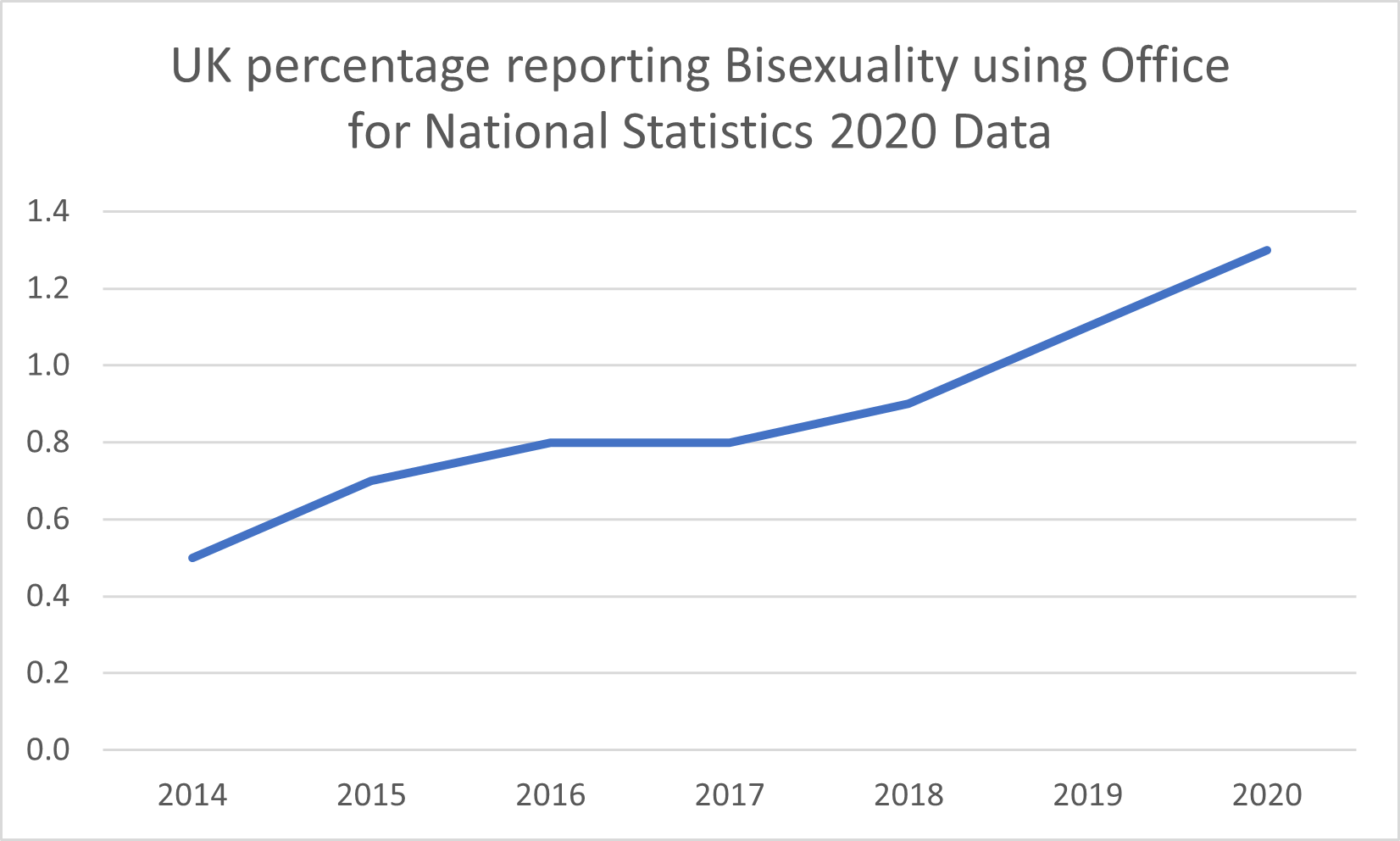The aim of this article is to briefly introduce and illustrate bisexuality and the issues bisexual people face.
Bisexuality has different definitions but is most commonly understood as an ‘attraction to both men and women’. It is important to note bisexuality can be further categorised into identity, behaviour, and feelings, which go beyond attraction and sexual desire (Barker et al, 2012).

Figure 1. UK percentage reporting Bisexuality using Office for National Statistics 2020 Data
Although largely heterosexual, current data from the Office for National Statistics indicate approximately 1.3% of the UK population identify as bisexual, compared to 1.8% as gay or lesbian, 0.7% as other, and 1.9% as refusing to report or don’t know. Data from 2014-2020 indicates the number of people reporting to be bisexual has more than doubled, from 0.5% in 2014 to 1.3% in 2020 (See Figure 1). This trajectory may mean more people would identify as bisexual today and display attraction to more than one gender.
Gender is not binary, therefore bisexuality can also be defined as an ‘attraction to more than one gender’, broadening the inclusivity of the term. In addition, pansexuality is sometimes categorised within the bisexual umbrella and refers to attraction regardless of gender. It is a common misconception that bisexual people do not experience homophobia. However, they can also experience biphobia, a distinct form of discrimination that directly relates to individuals who identify as bisexual.
Negative stereotypes
Stereotypes linked to bisexuality include seeing, referring to, or describing bisexual people as ‘promiscuous’, ‘greedy’, or ‘incapable of monogamy’. Additional stereotypes relate to parenthood and relationship stability, assuming bisexual people may leave a relationship for someone of a different gender or imposing a view that bisexual people are objects to fulfil sexual desires. These views are very damaging to bisexual people. They impose a view of monogamy as the only possible, valid form of family, reinforcing heteronormativity and that non-heterosexual, non-monogamous sex is deviant. This stereotype also suggests that all bisexual people have more than one partner. As with other sexual identities, there is a range of relationship types experienced by bisexuals, from monogamous to polyamorous. These stereotypes oppose the recognition and liberation of bisexual people to self-define and self-express their identity.
Bisexual invisibility
The assumption is that people in monogamous relationships are either heterosexual or homosexual, typically referred to as ‘straight’ or ‘gay’ relationships. These terms make bisexuality within monogamous relationships invisible, failing to recognise that bisexual people remain bisexual in monogamous relationships. This also leads to questions about someone’s bisexuality, as if this is dependent upon regular physical intimacy with more than one gender. Bisexuality is a valid, natural part of human sexuality and there is a need to develop the language used to serve this inclusivity. Adjusting language to use, for example, ‘same gender relationship’, instead of ‘gay/lesbian relationship’ or ‘partner(s)’ instead of ‘girl/boyfriend’, is just one simple and inclusive way to help address bisexual invisibility.
An extension of bisexual invisibility is bisexual exclusion and marginalisation
Actions bring unconscious bias into everyday practice of health and social care. For example, excluding data collection for bisexual people by merging data points for bisexual people with gay, lesbian, or heterosexual people could fail to consider or exclude bisexuality in policy and services. This point is especially relevant to healthcare professionals engaged in research or service development. For example, in a sexual health research context, avoid just using phrases such as ‘men who have sex with men’ which groups data about gay and bisexual men together, and instead add ‘men who have sex with men and women’ for clarity. Similarly, for women and non-binary individuals, these labels in research can reinforce existing stereotypes and contribute to bisexual invisibility. Providing options for patients and participants to self-identify may help distinguish bisexual people as a distinct population and help understand their health needs.
By working together everyone should aim to tear down assumptions about how bisexual people choose to form relationships and families, challenge the stigma surrounding sex, and give bisexual people the representation they deserve, specifically one that is not built on stereotypes and assumptions.
Get involved
- Join the PDA LGBT+ network here.
- Follow the PDA LGBT+ Network on social media using the hashtag #PDAlgbt
- Contact the PDA LGBT+ Network committee know by emailing lgbt@the-pda.org
Learn more
- The Bisexuality Report: Bisexual inclusion in LGBT equality and diversity
- Sexual orientation, UK
- Troglo x PDA sexuality and gender factsheet
- Tackling biphobia



By Soh Xi Ken (he/him), Honorary Secretary of the PDA LGBT+ Network, Joshua Wells (he/him), senior clinical lead at LVNDR Health and co-opted member of the PDA LGBT+ Network, and Adam Pattison Rathbone (he/him), lecturer in social and clinical pharmacy at Newcastle University.
Not yet a PDA member?
If you have not yet joined the PDA, we encourage you to join today and ask your colleagues to do the same.
Membership is FREE to pharmacy students, trainee pharmacists, and for the first three months of being newly qualified.
Read about our key member benefits here.